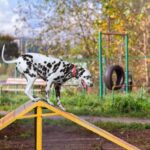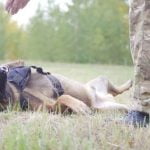Are you struggling with a dog who seems to chew everything in sight? If so, you’re not alone. Many pet owners find themselves dealing with this common behavior issue. Understanding the root of the problem is the first step in solving it, and that’s exactly what we’ll explore in this article on how to train your dog to not chew.
Chewing is a natural behavior for dogs, but when it becomes destructive, it can be frustrating and concerning for pet parents. In this article, we’ll delve into the reasons why dogs chew and provide practical tips for addressing the issue.
We’ll start by examining the underlying reasons behind this behavior and then move on to training basics, puppy proofing, choosing appropriate chew toys, redirecting behavior, providing adequate exercise and mental stimulation, addressing bad habits early on, and knowing when to seek professional help. By understanding why your dog chews and learning effective training techniques, you can help prevent destructive chewing and foster a positive relationship with your furry friend.
Training Basics
When it comes to training your dog not to chew, positive reinforcement and consistency are key. Using positive reinforcement, such as treats or praise, to reward your dog when they choose not to chew on inappropriate items will help them understand what behavior is desired. It’s important to be consistent with this approach, so your dog can learn the difference between acceptable and unacceptable chewing.
To effectively use positive reinforcement and consistency in training your dog not to chew, consider the following tips:
- Always have treats handy: Keep small, tasty treats on hand to immediately reward your dog when they refrain from chewing on inappropriate items.
- Use verbal praise: In addition to treats, verbal praise such as “good job” or “good boy/girl” can also reinforce the desired behavior.
- Redirect their attention: When you catch your dog chewing on something they shouldn’t be, redirect their attention to a proper chew toy and then praise them when they begin chewing on it instead.
Consistency is equally important in preventing unwanted chewing behavior in dogs. Make sure that all members of the household are on board with the training plan and consistently enforce the rules. If one person allows the dog to chew on a shoe while another reprimands them for it, it will create confusion for your pet.
By utilizing positive reinforcement techniques and staying consistent with training methods, you can effectively teach your dog not to chew on inappropriate items. Remember that patience is key when it comes to training any behavior in dogs. With time and dedication, you can help your furry friend develop good chewing habits.
Puppy Proofing
Puppies, just like human babies, explore the world around them using their mouths. This natural behavior often leads to chewing on objects that are not meant for chewing, such as shoes, furniture, and electrical cords. To prevent destructive chewing and keep your puppy safe, it’s essential to puppy-proof your home.
Start by removing items that your puppy could chew on and potentially swallow, such as small toys, coins, jewelry, or anything else that could pose a choking hazard. Keep electrical cords out of reach and use cord protectors to prevent your puppy from getting electrocuted. Pick up any items off the floor that you don’t want your puppy to chew on.
In addition to removing potential hazards from your puppy’s reach, providing appropriate chew toys can help redirect their natural chewing behavior onto acceptable items. Make sure the toys are durable and safe for your puppy to chew on without posing a risk of choking or intestinal blockage. By creating a safe environment for your dog and providing them with appropriate outlets for their chewing instincts, you can help prevent destructive chewing and keep both your pet and belongings safe.
| Items to Remove | Appropriate Chew Toys |
|---|---|
| Small toys, coins, jewelry | Durable rubber toys (Kong), nylon bones |
| Electrical cords | Rope toys, puzzle toys |
Proper Chew Toys
When it comes to training your dog not to chew on things they shouldn’t, providing them with the proper chew toys is essential. By choosing the right toys for your dog, you can help redirect their chewing behavior and prevent them from destroying your belongings.
Here are some tips for choosing the best chew toys for your dog:
- Size and Texture: Choose toys that are appropriate for your dog’s size and breed. Avoid toys that can be easily torn apart or swallowed.
- Durable Materials: Look for chew toys made of durable materials such as rubber or nylon. These types of toys can withstand heavy chewing and last longer.
- Interactive Toys: Consider interactive toys such as treat-dispensing puzzles or rubber balls with hollow centers. These toys provide mental stimulation and keep your dog engaged.
It’s important to rotate your dog’s chew toys regularly to keep them interested and prevent boredom. Additionally, always supervise your dog while they are playing with their chew toys to ensure their safety.
By providing your dog with the right chew toys, you can help satisfy their natural urge to chew while protecting your home from destructive behavior. Remember to regularly inspect their toys for signs of wear and tear, and replace them as needed to keep your furry friend happy and entertained.
Redirecting Behavior
One of the most effective ways to prevent your dog from chewing on your belongings is to redirect their behavior towards appropriate chew toys. When you catch your dog in the act of chewing on something they shouldn’t, firmly say “no” and take the item away.
Immediately replace it with one of their designated chew toys and praise them when they start chewing on it instead. This helps them understand what items are off-limits and which ones are okay for them to chew.
It’s important to provide a variety of suitable chew toys for your dog to prevent boredom. Different textures, shapes, and sizes can keep them engaged and satisfied. Look for toys that are durable and safe for your dog to play with, such as rubber or nylon chews, puzzle toys, or stuffed Kongs. Avoid toys that can easily be torn apart into small pieces, which could be a choking hazard.
Consistency is key when redirecting your dog’s chewing behavior. Always have their approved chew toys easily accessible and encourage them to use these items whenever they feel the urge to gnaw on something. With patience and repetition, your dog will learn what is acceptable to chew and what is not. Remember that positive reinforcement goes a long way in teaching good behavior-praise and rewards will reinforce the desired actions in your pet.
| Chew Toy Varieties | Examples |
|---|---|
| Rubber Chews | Kong Classic Dog Toy |
| Nylon Chews | Nylabone Dura Chew Textured Ring |
| Puzzle Toys | Outward Hound Hide-A-Squirrel Puzzle Toy |
Exercise and Mental Stimulation
Interactive Toys and Games
One way to keep your dog from chewing on things they’re not supposed to is to provide them with plenty of mental stimulation. This can be achieved through interactive toys and games that challenge your dog’s problem-solving skills. Toys such as puzzle feeders, treat-dispensing balls, and interactive play mats are great options to keep your dog engaged and entertained.
Regular Exercise
In addition to mental stimulation, it’s important to ensure that your dog gets enough physical exercise on a daily basis. Dogs that are under-stimulated or have excess energy may resort to destructive chewing out of sheer boredom. Make sure to take your dog for regular walks, engage in playtime, and consider activities such as agility training or fetch to help them burn off excess energy.
Training Sessions
Training sessions can also serve as a form of mental stimulation for your dog. Teaching them new tricks or practicing obedience commands not only keeps their mind engaged but also helps strengthen the bond between you and your furry friend. Consider enrolling in a training class or setting aside time each day for short training sessions to keep your dog mentally sharp and less likely to engage in destructive chewing behavior.
By incorporating exercise and mental stimulation into your dog’s daily routine, you can help prevent boredom-related chewing and provide a healthy outlet for their energy while also reinforcing positive behaviors.
Nipping Bad Habits in the Bud
Addressing chewing early on is crucial in preventing it from becoming a long-term habit for your dog. Catching and addressing the behavior in its early stages can help set the tone for appropriate chewing habits as your dog grows older.
Supervision and Correction
One of the most effective ways to address chewing early on is through close supervision and immediate correction. Keep a close eye on your dog, especially during their puppy stage when they are more prone to exploring and chewing. If you catch your dog in the act of chewing something they shouldn’t be, firmly say “no” and redirect their attention to a proper chew toy.
Consistency Is Key
Consistency is crucial when addressing chewing habits in dogs. Make sure everyone in the household is on the same page when it comes to correcting inappropriate chewing behavior. Mixed signals can confuse your dog and make it harder for them to understand what is acceptable.
Positive Reinforcement
Using positive reinforcement when your dog chews on appropriate toys or objects can help encourage good behavior. When you see your dog choosing a chew toy over something they shouldn’t be chewing, offer praise or a treat to reinforce this behavior. Positive reinforcement helps create a positive association with appropriate chewing, making it more likely that your dog will continue to choose the right items to chew on.
Seeking Professional Help
In some cases, despite your best efforts, you may find that your dog’s chewing behavior persists. When this happens, it may be time to seek professional help from a dog trainer or behaviorist. These experts can provide specialized guidance and training techniques tailored to your dog’s specific needs, and can offer valuable insight into the root causes of the chewing behavior.
A qualified dog trainer or behaviorist will be able to assess your dog’s behavior and provide a customized training plan to address the chewing issue. They may also be able to identify any underlying factors contributing to the behavior, such as anxiety or boredom, and recommend additional strategies to address these issues. With their expertise and experience, they can help you navigate the training process more effectively and make adjustments as needed.
It’s important to remember that seeking professional help is not a sign of failure, but rather a proactive step towards finding a solution that works for both you and your furry friend. By enlisting the help of a trained professional, you are demonstrating your commitment to addressing your dog’s chewing behavior in a responsible and effective manner.
With their assistance, you can work towards creating a harmonious environment where your dog feels secure and fulfilled, ultimately reducing their desire to chew on inappropriate items.

Welcome to the blog! I am a professional dog trainer and have been working with dogs for many years. In this blog, I will be discussing various topics related to dog training, including tips, tricks, and advice. I hope you find this information helpful and informative. Thanks for reading!





